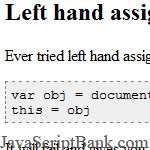









 Cette façon de faire pour l'article va vous expliquer comment d'assigner l'objet spéciaux --
Cette façon de faire pour l'article va vous expliquer comment d'assigner l'objet spéciaux -- this dans le langage de programmation JavaScript. this objet, et les solutions pour ce problème.
Have you ever experience a time when the calling object ‘this’ needed to be override and somehow you just couldn’t do that? You tried left hand assignment but it just won’t work? wondering how can ‘this’ object be overridden in JavaScript but can’t find the correct answer on Google? This article will explain how this can be done.
Ever tried left hand assignment to override ‘this’ object?
var obj = document.getElementById("button");
this = obj
It will fail and gives you ‘invalid assignment left-hand side‘.
There is a function in JavaScript, Call() which can help you override ‘this’ object or specify the ‘this’ object. Let’s consider the following example,
function example(a,b)
{
this.value == 'button'?alert(a):alert(b);
}
var textobj = document.getElementById('input_relink');
example.call(textobj, 'It is a button!', 'It is not a button');
We look at a text box and check whether the user key in ‘button’. But we uses ‘this’ object to verify the input text in the function example which takes in two parameter as shown above. The Call() method is used whenever you wish to override ‘this’ object which is placed at the first parameter and the rest of the parameter will be exactly the same as the method parameter. Hence, we used the function in this way for the above example because it has two parameter.
//override 'this' with object 'textobj' example.call(textobj, 'It is a button!', 'It is not a button');
If we have another function which takes in 3 parameter, we will do this.
function example(a,b, c)
{
this.value == 'button'?alert(a):alert(b);
alert(c);
}
var textobj = document.getElementById('input_relink');
example.call(textobj, 'It is a button!', 'It is not a button', 'Completed');
You can also used it without parameter like the one illustrated below,
var o = { x: 15 };
function f()
{
alert(this.x);
}
f.call(o);
Using Call() method restrict your variable given on the method. On the other hand, we can use another method Apply() which override the ‘this’ object giving the second parameter as an array.
The difference between call and apply method is the parameter needed to use them. For Call() method it depends on the parameter of the function as shown above. But for Apply() method it can have more than the amount of parameter in the function (since it takes in an array). Similarly, the first parameter of both methods are used to override ‘this’ object. Let’s consider the following example,
var o = { x: 8 };
function example()
{
// arguments[0] == object
var sum = 0;
for(var i = 1; i < arguments.length; i++)
{
sum+=arguments[i]
}
alert(sum+ this.x);
}
example.apply(o, 1, 2, 3, 4)
I am using the depreciated argument array to look through the argument being passed into the function, sum them up, alert to the user. Similarly, i can do this using an array.
var o = { x: 8 };
function example(a, b, c)
{
alert(this.x+a+b+c);
}
example.apply(o, [1,2,3])
Pretty simple isn’t it?